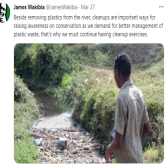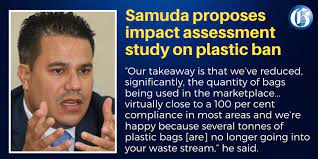
How can environmental activists persuade governments to address the issues of climate change and plastic pollution as the inextricable problems they are? Irene Maithya of Kenya’s Moi University looks at two key figures making waves on opposite sides of the Atlantic.
Plastic Pollution
Scientists are warning politicians and stakeholders immersed in climate change policy not to forget that the world is also in the midst of a plastic waste crisis. They fear that so much energy is being expended on emissions policy that tackling plastic pollution will be sidelined. Research has shown that plastic pollution and climate change are not separate. The issues are actually intertwined – and each makes the other worse.
The Link between Plastic Pollution and Climate Change
Manufacturing plastic items adds to greenhouse gas emissions, while extreme weather such as floods and typhoons associated with a heating planet will disperse and worsen plastic pollution in the sea. This causes climate change. Marine species and ecosystems, such as coral reefs, are taking a double hit from both problems. Reefs and other vulnerable habitats are also suffering from the seas heating, from ocean acidification, pollution from farms and industry, dredging, development, tourism and over-fishing. And in addition, sea ice is a major trap for microplastics, which will be released into the ocean as the ice melts due to warming.
Calling on Stakeholders at the COP 26 U.N Climate Change Conference
Researchers want participants and politicians at the COP 26 U.N Climate Change Conference to address all these issues – and not to allow climate change to take all the policy “bandwidth”. Climate change is undoubtedly one of the most critical global threats of our time. Plastic pollution is also having a global impact; from the top of Mount Everest to the deepest parts of our ocean. Both are having a detrimental effect on ocean biodiversity; with climate change heating ocean temperatures and bleaching coral reefs, to plastic damaging habitats and causing fatalities among marine species. The compounding impact of both crises just worsens the problem. It’s not a case of debating which issue is most important, it is realizing that the two problems are interconnected and require joint solutions.”
Environmental Activism on Plastic Pollution in Kenya and Jamaica

Environmental activists are in often cases non-state actors who play a crucial role in driving policy change. In Kenya, James Wakibia, an environmental activist has launched a spirited campaign against single use plastic and is known internationally. He has in the past years embraced diverse communication strategies. Some of the strategies included petitions to the government, use of social medial platforms and photography. This paid off and he is credited as one of the non-state activists who drove the communication strategies led to the ban of single use plastics. Kenya has made some remarkable strides with the ban of use of single use plastics in national parks and wildlife conservation areas.
On the other hand the main activist in Jamaica has been the young Senator Matthew Samuda who, with no ministerial responsibility, is lauded as the driver behind the single use plastics ban and is therefore considered the policy champion having tabled before the senate the motion that saw the enactment of Jamaica’s plastic ban.

Solutions
However, studies show that more needs to be done. And most importantly we must recognise that the solutions to plastic pollution and the broader challenge of climate change can and must come through different strategies, as embraced by environment activists to mitigate the gap left by governments.
Environment activism linkages between climate change and plastic pollution can stimulate innovation, inform policy, build education pathways between technical, environmental and climate roles and expand opportunities on tackling climate-related problems.

Well done Irene. Contemporary and critical issues you are raising here.
We need to take care of our planet by planning for good environmental protection by engineering waste plastic and value addition by using this recovery matirals adding value and have stekholders investmenting in this area for sustainability and resources utilisation both localy and international our slogan is planet care for green economy for sustainable development
There is need to change our attitude towards single use plastic .This cannot be addressed by the governments only, it is a responsibility of each and every individual to support his government to rule on a complete ban of plastic on this earth
There is need for States to come up with innovative solutions to the climate change issue. Activists play a key role in creating public awareness.
Great work and a great eye opener, thank you
Great work Irene!!!
“Environment activism linkages between climate change and plastic pollution can stimulate innovation, inform policy, build education pathways between technical, environmental and climate roles and expand opportunities on tackling climate-related problems.” (Irene 2021), is a eye opener to the unsung environmental issue that has already become the worlds contributing factor to unhealthy environment, We also need to think of recycling effect that does not solve the burden but rather postpones its dumping time. It would be the better world to live in with 0 production of plastics.
Plastic pollution is so silent but seems to have very profound impact. We require such incisive exposition of this problem to prick the attention of policy makers globally. We’ll done Irene
This is well written piece of work Irene. Keep up the spirit. Indeed environmental defenders through activism has enabled communities at local and global level realize the true benefit of protecting the environment to avert the inherent dangers of the changing climate. Pollution or environmental contamination if any nature affecting the lives of communities has been fought in courts and positive results have been seen albeit with a cost in terms of defenders lifes in some instances. It is through such activism that innovative ideas are identified and adopted thus saving our planet and life’s in it.
The fight against unfettered proliferation of plastics and other non-biodegradable substances is one of the most important fights of our time if we are to preserve the planet earth and its biodiversity as the natural habitat for fauna and flora. All citizens of goodwill across the globe should take up the fight against plastics without any equivocation. In this respect, I therefore, wish to identify with the sentiments of Irene Maithya and her colleagues, and truly appreciate her efforts to create awareness against non-recycleable plastics.
I always enjoy reading your insightful and eye-opening articles. Indeed more needs to be done to curb plastic pollution, not only by non state actors. State agencies need to step up and enact more environment-friendly policies.
Environmental activists stand out as the alternative voice to champion for the environment conservation from the detrimental/adverse effect of plastics pollution and climate challenges. Well done! Ms. Irene, for bringing out this effectively. Indeed, environmental activists have immense role to play especially by assisting the government and state agencies to think outside of the box in coming up with adequate policies and legislative measures to curb environmental threats in this 21st century.
Good thing there are some heroes like you out here saving the environment! Very insightful piece 👍
Indeed the growth in environmental activism has spurred the creation of environmental policy by national governments. Over the years several nations have created a basis of environmental policy, establishing new laws & government departments, agencies, & regulatory bodies to address & oversee environmental issues. If you happened to encounter my good friend James Wakibia & asked him anything to do with environmental activism, it dawns on you that there are many non-state actors, who though challenged by external factors like meagre finances or government bureaucrat, still passionately pursue the environmental agenda, the same would apply to Senator Matthew Samuda & many other unsung heroes.
Acknowledging their input in your article is priceless, their efforts are truly continuing to bear fruit & their voices are resonating globally.
Superb piece,!
Indeed whereas the environmental activists play a critical role in spearheading the debate on this greatest threat of our lifetime, much more need to be done by government and State agencies on policy implementations to curb plastic pollution. Good piece Doc!
Bringing out the detrimental effects of plastics like you did, will definitely draw anyone’s attention to their own immediate environment.With evident climate changes, things like global warming and the extreme weather conditions that you pointed out, affect the general population; activists or not. We as a nation and general world population should therefore make it an individual effort to support activists as well as curb this crisis at the grassroot level.
A very insightful and enlightening read Irene. Keep up the good job.
The activist in Jamaica, Senator Matthew Samuda stands out for me. There is need for more young African leaders to emulate the same as a way of actively managing climate change. A timely and relevant piece of writing indeed.
We have a long way to go when it comes to single use plastic. How I wish more individuals could join activists on the frontline against single use plastic and help us get solutions for the same . Thank you for this article Irene.
Really interesting to hear about the individuals who are playing a role in changing the way we treat the planet. Making laws can seem like a dry and dusty activity but these activists who change laws are anything but!